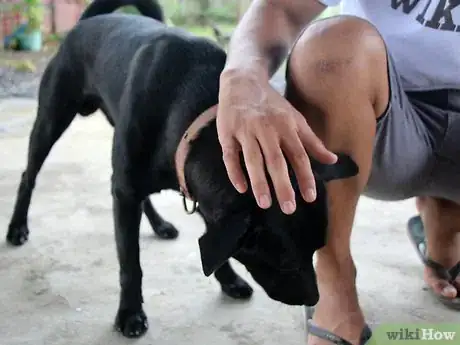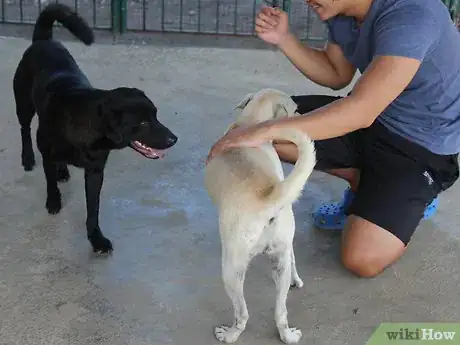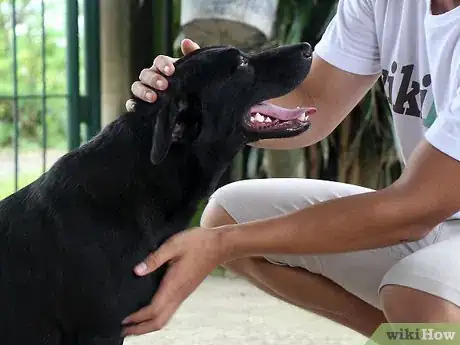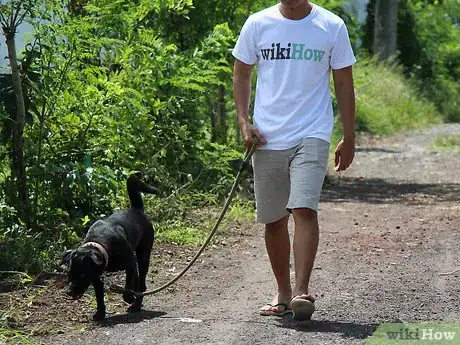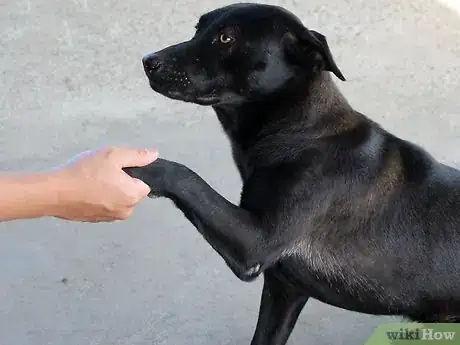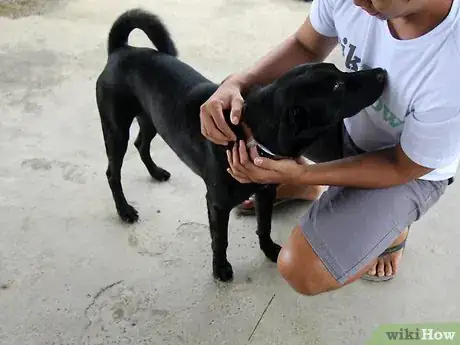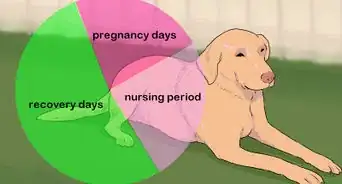This article was co-authored by Cameron Thompsen. Cameron Thompsen is a Dog Trainer and Human Coach, as well as the Owner and Founder of Hope2K9 Foundation. With nearly two decades of experience, she specializes in working with dogs and their owners on behavior issues ranging from severe anxiety, reactivity, as well as aggression and fear-based problems. She works with all dogs at Hope2K9 so that they are fully trained before adoption, and provides lifelong support to dog owners after adoption.
This article has been viewed 43,975 times.
If you're looking for a family-friendly, loving, and intelligent dog, a Labrador Retriever will fit your needs. They can sometimes be a handful, but that's what this article is for, to help you understand what's involved and know how to respond to the high energy levels of this wonderful dog.
Steps
Selecting your Labrador Retriever
-
1Consider your own ability to own a Lab. Labs can be a handful, and they definitely need a lot of exercise. Research the temperament and activity levels of a labrador retriever. Then, consider the following:[1]
- Can I give him walks? Labs need at least one, sometimes two, walks a day.
- Can I provide for him? Labs need food, toys, food and water bowls, bones, beds, etc. That can cost a lot of money.
- Can I give him exercise? Labs not only need walks, but play time. Throwing a ball around for half an hour every day, along with one or two walks, can often be a hassle.
- Will my kids/spouse help with the dog? If you are the only one taking care of the dog, he's not going to consider the other family members his pack. If one day you are gone and they are left to take care of him, he might not be comfortable. Everyone in the family has to have some kind of connection with a Lab, especially because Labs are loyal.
- Can I give him love? What Labs need most is love. Will you be mad if he licks your face? Will you let him cuddle with you? Labs are caring, loving dogs. If you don't pet them or hug them, they won't think you appreciate them being there. You need to make sure he knows you will always love and care for him.
-
2Consider your choices. Will you buy a shelter dog, a dog from the pet store, or from a backyard breeder (someone who breeds dogs from their own home).
- Because shelters often have an overload of dogs who need homes, their dogs are often free or available at a minimal cost which covers vaccinations, worming, and incidental care. However, it is important to understand that shelter pets may have been strays or abandoned, and might have health or trust issues. It is prudent, therefore, to ask the shelter workers if they know the background of the dog.
- A dog from the pet store is usually a safe bet, even though they can cost more money and, sometimes, a lot of money.
- Purchasing from a qualified, registered breeder will ensure quality and also gives you someone who will answer your questions when needed. Check with the relevant dog breeder's association for suggested breeders and to be certain that the breeder is registered.
- Backyard breeders may be cheaper, but they may not be running a legal operation and may not have the dog's best interests at heart. Always find out first if the breeder is reputable.
Advertisement -
3Evaluate your current living situation with the individual dog in mind. If the Lab you want is the runt, he might be able live in a big apartment. If the Lab you have your eyes on is one of the biggest dogs in the litter, it will be better for the dog if you live in a house with a fenced yard. If he has an ongoing medical condition, it is prudent to ensure that you are close to a vet or pet hospital. Keep in mind that all Labs need a large play space such as a yard or park.[2]
-
4Choose your dog. Be sure to look at the little things that won't affect your relationship with him but can still be an important part of your personal choice, such as:[3]
- Color
- Age
- Gender
- Markings (white spot on chest).
-
5
Getting Used To Owning a Labrador Retriever
-
1Give your Lab a name. Your dog needs a name. If you pick a name that fits his personality, you may have to be with him for a couple of days. However, it's important to try to choose the name as quickly as possible. You will use this name for the rest of your life, and you don't want your Lab to grown up thinking his name is "puppy".
- Here are the top 10 names for male dogs:[citation needed] Max, Buddy, Charlie, Jack, Cooper, Rocky, Toby, Bear, Jake and Buster.
- Here are the top 10 female dog names:[citation needed] Bella, Lucy, Daisy, Molly, Lola, Maggie, Sadie, Chloe, Sophie and Bailey.
-
2Accept your dog's shyness. It's natural for the puppy to be shy and uncomfortable when first taken away from his mother to a completely different environment with strangers taking care of him. Your dog will open up to you eventually, but until then, keep loving and caring for him. He will soon understand you won't do anything to hurt him.
-
3Introduce your Lab to your neighborhood. Since you will be taking him on walks often, make him comfortable with his surroundings. For the first few days, take him on long strolls, around the neighborhood. He will enjoy a really slow walk. Let him sniff everything he wants to.
-
4Schedule a vet appointment. The vet will give you pointers on how much the dog should eat and how often. The vet will give you the dog's weight and tell you if he's overweight or underweight. Your Lab will need some vaccinations; your vet will give these to him if they were not already taken care of by the shelter or previous owner.
Taking Care of your Labrador Retriever
-
1Give your dog plenty of food. Labs are always hungry, so make sure he gets proper nutrition.[4]
-
2Introduce him to other dogs. There will be other dogs in your neighborhood, so it's good for your dog to get to know them. Schedule play-dates. It is healthy for your dog to play with other dogs. If your dog spends all his time with people, he might be uncomfortable, nervous, and scared is he sees or makes contact with another dog.
-
3Have your Lab neutered or spayed if it has not already been done. Unless you want your dog to breed, prevent the increase of unwanted puppies by doing the right thing.
-
4Take your Lab on walks. Walks are very important to dogs. They need time to go out and get fresh air. Either do two short walks a day, or one long walk a day. If you do not have a chance to take him for a walk, the best you can do is play with your dog.
-
5Train your Lab. Labs are very intelligent, so it shouldn't take long for your dog to understand and respond to commands and expectations. Potty-training should only take one to four months. Training him to sit, lie down, shake, stay, roll over, etc. can be easy if you are dedicated, determined, and patient. Start to train your dog when he is young, though; the older a dog gets, the harder it is to train him.[5]
-
6Enjoy the experience. Having any dog is fun, but having a Lab is even better. Be sure not to always be negative about your dog pooping on the carpet. Be positive about your dog learning a new trick!
Community Q&A
-
QuestionChief is 18 months old, from Leader Dog for the Blind. While he is on service with the harness and short leash, he is always distracted by other dogs. What can I do?
 Community AnswerYou should contact the organization. Guide dogs are specifically trained to ignore normal response patterns. Another option is to keep the dog's attention on the master by correcting immediately with a tug on the harness and then rewarding when they come back to guide mode. A pat on the back usually works as a reward for labs, they are reinforced with affection. Don't get mad, just give the dog an alternative that is more fun than the other dog.
Community AnswerYou should contact the organization. Guide dogs are specifically trained to ignore normal response patterns. Another option is to keep the dog's attention on the master by correcting immediately with a tug on the harness and then rewarding when they come back to guide mode. A pat on the back usually works as a reward for labs, they are reinforced with affection. Don't get mad, just give the dog an alternative that is more fun than the other dog. -
QuestionCan Labs be caged or chained?
 ChristopherTop AnswererAs long as you won't be abandoning your lab when you cage or chain him, it's okay. Be around to collect him after a few minutes. Depending on the weather, a good fifteen minutes is okay. However, Labs do like room to run and "exercise". Set some boundaries with himm and adhere to these boundaries. Most Labs will like and want your presence when outside. They easily feel left out and hurt if you leave them caged or chained for too long.
ChristopherTop AnswererAs long as you won't be abandoning your lab when you cage or chain him, it's okay. Be around to collect him after a few minutes. Depending on the weather, a good fifteen minutes is okay. However, Labs do like room to run and "exercise". Set some boundaries with himm and adhere to these boundaries. Most Labs will like and want your presence when outside. They easily feel left out and hurt if you leave them caged or chained for too long. -
QuestionHow do I prevent random street dogs from coming near my dog? She hates them.
 Community AnswerThis can sometimes be avoided if you put yourself between your dog and the street dog. For example, if the street dog is on the left side of the street, walk closely next to your dog on the left.
Community AnswerThis can sometimes be avoided if you put yourself between your dog and the street dog. For example, if the street dog is on the left side of the street, walk closely next to your dog on the left.
References
- ↑ https://www.thelabradorsite.com/6-things-to-consider-before-buying-a-labrador/
- ↑ https://www.thelabradorsite.com/6-things-to-consider-before-buying-a-labrador/#yard
- ↑ https://www.thelabradorsite.com/choosing-the-right-dog/
- ↑ https://www.thelabradorsite.com/how-to-feed-a-labrador/
- ↑ https://www.labradortraininghq.com/category/labrador-training/








